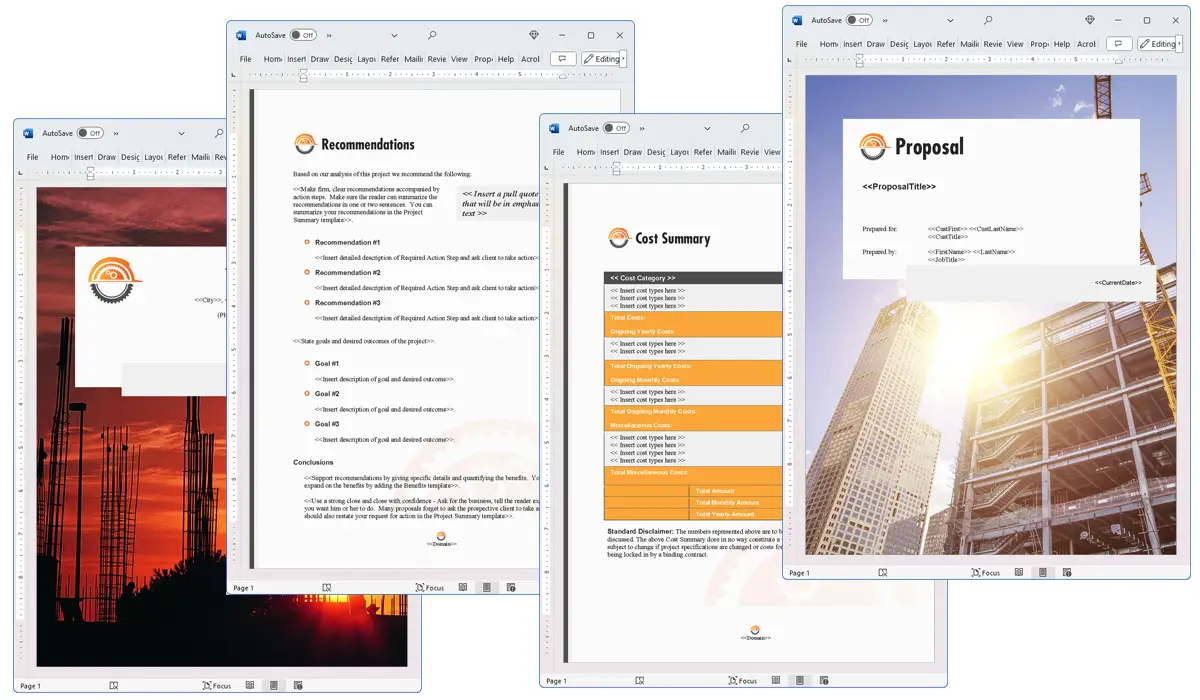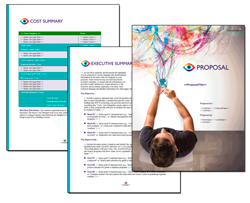What is the Estimate chapter used for?
Proposal Kit Professional Bundle adds more design themes, all six Contract Packs,
a project management library, and Expert Edition software.

Illustration of Proposal Pack Construction #6
We include this Estimate chapter template in every Proposal Pack, along with thousands more. You assemble this chapter with others in various combinations to create custom-tailored business proposals, plans, reports, and other documents. Proposal Packs apply custom visual designs to the templates, giving the final documents a consistent professional finish.
 DOWNLOADABLE, ONE-TIME COST, NO SUBSCRIPTION FEES
DOWNLOADABLE, ONE-TIME COST, NO SUBSCRIPTION FEES
Overview of the Estimate Chapter
The Estimate chapter is an important component used within a business proposal document to present potential costs associated with a project. This chapter is fundamentally designed to provide a preliminary financial overview, helping clients understand what financial commitment they might be entering into before detailed costs are fully established. Unlike chapters that offer precise costs, the Estimate chapter serves as an initial, educated guess that helps guide the decision-making process in the early stages of project discussions.
How is the Estimate Chapter Used?
In the course of preparing a business proposal, the Estimate chapter is employed to set the financial stage. It is used when exact cost figures are not available or when a project is still in the conceptual or preliminary phase. By providing an estimate, businesses can communicate the anticipated budget requirements without committing to specific numbers, which may change as the project details are further developed. This chapter allows flexibility and transparency in negotiations, ensuring that potential clients are not surprised by costs down the line.
What is Included in the Estimate Chapter?
Typically, the Estimate chapter will include several key elements:
- Estimated Costs: A breakdown of the costs associated with different aspects of the project, such as labor, materials, and other resources.
- Basis for Estimates: Explanation of how these costs were calculated, which might include historical data, industry standards, or cost models.
- Conditions or Assumptions: Any assumptions made to calculate the estimate, such as time of year, resource availability, or economic conditions.
- Exclusions: Clearly states what is not included in the estimate, preventing misunderstandings about the scope of the project.
- Revision Notes: If applicable, notes about potential future revisions to the estimate can be mentioned, indicating that it is a dynamic and adjustable figure.
Use Case Examples for the Estimate Chapter
- Short Quotes: Useful for quickly giving a potential client a rough idea of the cost for smaller projects or services.
- Bids: Important for submissions where multiple vendors are competing, and preliminary cost estimates can make or break the deal.
- Contracts: Helps to set baseline costs before a detailed contract is drafted.
- Agreements: Assists in forming pre-contract agreements where costs are estimated before final negotiations.
- Summaries: Provides a snapshot of expected costs in executive summaries where decision-makers need quick, digestible financial insights.
Key Takeaways
- Preliminary Financial Guidance: The Estimate chapter serves to provide an initial cost outlook which helps in early project discussions.
- Flexibility in Proposals: Helps businesses present potential costs without binding them to specific figures prematurely.
- Elements of the Chapter: Includes estimated costs, basis for estimates, conditions, exclusions, and potential revision notes.
- Versatility Across Documents: Can be used in various types of proposal documents such as bids, contracts, and summaries.
- Foundational for Negotiations: Establishes a financial understanding that is crucial for smooth negotiations and client relationships.

Illustration of Proposal Pack Marketing #2
 What Our Clients Say
What Our Clients SayThis is a great product. Everything that you need to have professionally prepared proposals, business plans, etc. Love this product!"
McBIV Corporation
 4.7 stars, based on 845 reviews
4.7 stars, based on 845 reviewsAlternate Chapters
Related Chapters
Samples Using the Estimate Chapter
Document Layouts Using the Estimate Chapter
- Network Cabling Proposal
- Lighting Contractor Product and Service Sales Proposal
- Masonry Contractor Proposal
- Elevator and Escalator Sales and Service Proposal
- Software System Testing Project Proposal
- Contractor Bath and Kitchen Remodel Services Proposal
- Steel Erection Project Proposal
- Flooring Contractor Proposal
- Expression of Interest Proposal
- Clean Water Supply Project Proposal
- Machining Services Proposal
- Museum Conservation Project Proposal
- Painting Contractor Proposal
- Testing and Inspection Services Proposal
- Commercial Painting Project Proposal
- Parking Lot Expansion Proposal
- Siding Contractor Proposal
- Crop Production Proposal
- Glass and Glazing Contractor Proposal
- Estimate (Short)
- And more like these

The Estimate chapter and other chapters are integrated into a Word document as illustrated here in the Proposal Pack Contemporary #19 design theme. There are hundreds of design themes available, and every design theme includes the Estimate chapter template.
A proper business proposal will include multiple chapters. This chapter is just one of many you can build into your proposal. We include the complete fill-in-the-blank template in our Proposal Pack template collections. We also include a library of sample proposals illustrating how companies in different industries, both large and small, have written proposals using our Proposal Packs. This template will show you how to write the Estimate.
We include a chapter library for you to build from based on your needs. All proposals are different and have different needs and goals. Pick the chapters from our collection and organize them as needed for your proposal.
Using the Proposal Pack template library, you can create any business proposal, report, study, plan, or document.
 Ian Lauder has been helping businesses write their proposals and contracts for two decades. Ian is the owner and founder of Proposal Kit, one of the original sources of business proposal and contract software products started in 1997.
Ian Lauder has been helping businesses write their proposals and contracts for two decades. Ian is the owner and founder of Proposal Kit, one of the original sources of business proposal and contract software products started in 1997.By Ian Lauder
 Published by Proposal Kit, Inc.
Published by Proposal Kit, Inc.


 Cart
Cart
 Facebook
Facebook YouTube
YouTube X
X Search Site
Search Site